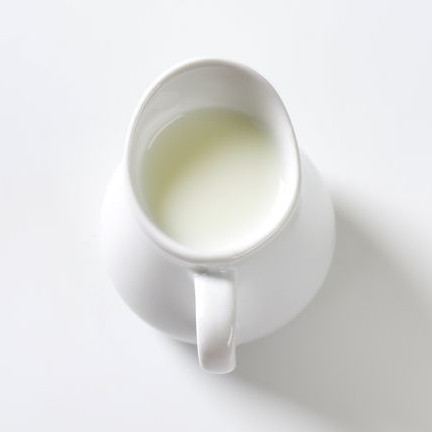
Milk
What is Milk?
Milk is a nutrient-rich white fluid secreted from the mammary glands of female mammals. In baking, it moistens batter or dough, and adds protein, color and flavor to baked goods.1
The most common form of milk in baking is non-fat dry milk (NFDM), which is dehydrated skim milk. The shelf life of dry milk is longer than liquid and easier to bulk transport. Dry milk helps to:
- Improve the texture and mouthfeel of baked goods
- Create a strong batter or dough from the protein
- Add fat and sugar to help provide a crisp crust, color, and flavor
Origin
Milk became common in food and diets with domestication of livestock around 9000-7000 B.C. Today, liquid milk is pasteurized, homogenized, and fortified before being packaged and sold.
Function
The Maillard reaction can be produced from the combination of proteins and lactose (fast-browning milk sugar) in milk at high temperature. The combination of proteins and lactose, along with fat, delays the staling of baked products. Especially, for lean bread doughs. If milk is used instead of water, the crust is softer in products like cream puffs and pan bread. Milk also reacts with flour in strengthening gluten formation. So, it is considered a dough strengthener.
Types/Variations
- Liquid milk: In the Western world, this mainly comes from dairy cattle. It is consumed after pasteurization, homogenization and fortification. It comes in all varieties of fat content, ranging from whole (3.5% fat) to reduced-fat (2%) to low-fat (1%) to nonfat (0-0.5% fat) or fat-free varieties.
- Non-fat dry milk (NFDM): This is ideal for because of it’s long shelf life. It is easy for bulk transport because it’s in powder form. In addition, NDFM can provide the same nutritional values as liquid, such as protein, carbohydrate, sodium, fiber, cholesterol, etc.
- Evaporated milk: It’s a concentrated, sterilized product with a concentration twice that of standard milk. 60% of its water has been removed. Shelf life can be up to a year if it’s canned and processed properly.
- Condensed milk: This is also concentrated, but not sterilized. Sugar is added, which is why it’s different than the evaporated form. About 50% of water has been removed from the whole milk, and the final product contains about 44% sugar. Shelf life can be from few months to a year.
Substitutes or alternatives
- Almond
- Soy
- Rice
- Oat
Application
Adding milk to dough will:
- Increase water absorption of dough. Dough will become softer compared to dough made with water.
- Increase pH of dough vs. water dough. Fermentation will be slower and fermentation tolerance will be slightly improved.2
- Increase bench time due to slow fermentation.
- Baked goods will color faster than water dough.
- Baked goods will show greater volume (improved capacity to retain gas), darker crust (presence of lactose), and longer shelf life (milk fat).
In baking formulations, fresh whole milk can be replaced with NFDM, butter and water. For every 100 g of whole milk, use 8.5 g NFDM, 3.5 g butter and 88 g water. NFDM is often used in pancake, muffin, biscuit, pancake mix, or sugar cookies.3
Evaporated milk is used for pie or cake, while condensed milk is the main ingredient in many desserts and sweets.
FDA Regulation
Milk is regulated by FDA in article 21CFR131.110 of the Code of Federal Regulations that pasteurized or ultrapasteurized before in final package form for beverage use, including various types, such as concentrated milk, dry whole milk, skim milk, nonfat dry milk, etc.4
References
- Baking Ingredients & Function: A Breakdown. Accessdata. 20 Jun 2016. https://ueat.utoronto.ca/baking-ingredients-function/. Accessed 6 Nov 2019.
- Milk in bread baking. Access data. 5 Jun 2019. https://chem.libretexts.org/Bookshelves/Biological_Chemistry/Book%3A_Chemistry_of_Cooking_(Rodriguez-Velazquez)/Understanding_Ingredients%3A_Dairy_Products/61%3A_Milk_in_bread_baking. Accessed 6 Nov 2019
- Roberts, A. J., Jewkes, M. D. Non-fat Dry Milk Recipes and Storage Recommendations. https://extension.usu.edu/duchesne/EZPlug/Uploads/FSC/Cooking_With_Food_Storage/dry_milk_Jan10.pdf. Accessed 6 Nov 2019
- “CFR-Code of Federal Regulations 21CFR131.11”. Accessdata.fda.gov. 01 Apr. 2019. https://www.accessdata.fda.gov/scripts/cdrh/cfdocs/cfcfr/cfrsearch.cfm?fr=131.110. Accessed 6 Nov 2019.

